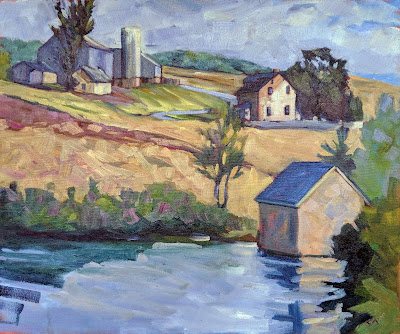I don’t need to go anywhere to see the beauty of autumn. It’s right here.
 |
| Thicket, by Carol L. Douglas |
Maine’s official state motto is Dirigo, which means, “I lead… slowly.” Or, as our unofficial state motto reads, “35 mph was good enough for my grandfather, and it’s good enough for me.” Route 1, the state’s major north-south (or east-west, depending on how you look at it) road, is mostly a twisty two-lane highway. For the most part, you can’t pass. It’s pointless to try, because there’s another slowpoke a mile ahead. Except when you get to Portland, where 55 means 77. Sometimes I go there just to remember how to drive fast.
As a recovering New Yorker, I’ve learned to slow down. In the summer, there will be out-of-staters bearing down on my bumper, and a few local idiots as well. They are often boiling more merrily than a lobster boil, waiting impatiently for their chance to pass.
 |
| Autumn Farm, by Carol L. Douglas. Available through Maine Farmland Trust Gallery. |
In the early stages of pandemic, my car went weeks without a fill-up, but recently I’ve been driving more—up to Schoodicto teach, and down to Portland for doctors’ visits. This week I painted with Plein Air Painters of Maineat a roadside rest stop in Newcastle. It’s about 45 minutes from my house. Alas, it was a misty, overcast day, and the marsh grasses’ color was muted. I painted a wild apple tree instead.
Engine lights came on as I headed home. I stopped and read the codes. There were twelve of them. My poor old Prius has 276,000 miles on it, and it’s getting fragile. No more long trips until I figure this out.
| The Dugs, by Carol L. Douglas. Available. |
We’re at a glorious moment in the seasonal pageant. The maples have stopped flaming red and yellow. Now the oaks are doing their star turn, arrayed in burnished gold. The other reticent tree that shines this time of year is the wild apple tree. They don’t have much color in their leaves, but they’re covered with bright red fruit. Johnny Appleseed may never have visited Maine, but his influence was certainly felt.
I usually don’t have red on my palette for landscape painting, since most reds in nature can be approximated with cadmium orange and quinacridone violet. However, there was a small ironwood tree in Wednesday’s painting. Its foliage was so intense that I couldn’t hit that note without a spot of naphthol red.
 |
| Annie Kirill doing a value study in plein air class at Thomaston. It’s been a spectacular year, weather-wise. |
The gold of the oaks is gorgeous, but it’s the last player on the autumn stage. In a few weeks, empty branches will be rattling in a fierce November wind, and these beautiful days will be a memory.
Autumn is my favorite time of year, but I never seem to get much painting done. I’m committing myself to being out there on every good day from now until the snow flies, capturing the last glimmers of summer beauty before it goes. And not wasting my time driving, either, but setting up in my own backyard.
A side note: with all the conversation about COVID, we forget the very real threat of Lyme Disease. This morning my husband found a tick embedded in his leg. Even after the first frost, they’re still hanging around. Have a care.






































